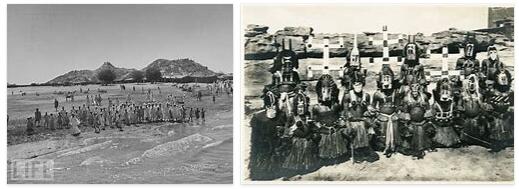Abu Mena (World Heritage)
According to areacodesexplorer, Abu Mena was the most important early Christian pilgrimage site in Egypt. It was built in the 5th century on the grave of the martyr Mena, who was executed in 296, and was expanded until the beginning of the 7th century. It was forgotten in the 11th century. The ruin complex, which has been on the red list since 2001, includes the city of Abu Mena with its hostels, baths, monasteries and churches.
Abu Mena: facts
| Official title: | Early Christian ruins of Abu Mena (Monastery of St. Menas) |
| Cultural monument: | Crypt church with tomb of the martyr Menas of Alexandria as well as baptistery, great basilica (67 m long and 32 m wide hall construction, 50 m long and 20 m wide transept), monastery and workplaces of an early Christian, North African city |
| Continent: | Africa |
| Country: | Egypt |
| Location: | southwest of Alexandria |
| Appointment: | 1979 |
| Meaning: | one of the most important early Christian pilgrimage sites |
Abu Mena: history
| 296 | Martyrdom of Menas of Alexandria |
| 5th / 6th Century | Construction of the baptistery with a marble baptismal font |
| 7th-9th Century | Construction of the three-aisled north basilica |
| around 850 | Construction of the today uncovered crypt, a five-aisled basilica (38 m long, 22.5 m wide) with a crypt 8 m lower and the grave of St. Menas of Alexandria |
| around 900 | Looting by Muslim Abbasids |
| around 1300 | Abandonment of Abu Mena |
| 1905 | archaeological excavations by Carl Maria Kaufmann |
| since 1961 | archaeological excavations by the German Archaeological Institute in Cairo |
| 2001 | Inclusion in the red list of the endangered world heritage due to the threat of rising groundwater from irrigation measures |
Wondrous spring in Lower Egypt
Not far from the port metropolis of Alexandria, the early Christian ruins of Abu Mena lie in the yellow desert sand. After his conversion to Christianity in the course of the persecution of Christians, he was tortured and finally executed because of his belief, is considered a saint and martyr of the Egyptian Copts. The staunch advocate of the still young religion and patron saint of merchants was probably a legionnaire in the service of the Roman emperor, whose life and miraculous deeds are recorded in Coptic, Greek and Ethiopian scriptures. His worship by the early Christian community quickly spread across Egypt, and pious pilgrims made pilgrimages from all directions to his tomb, which was in an unadorned catacomb for the first three centuries.
If the legend is to be believed, friends of Menas wanted to bring the body home with camels. However, the stubborn beasts of burden did not take another step when they reached the edge of the Libyan desert. Menas’ friends saw this as a sign of God and decided to bury their dead friend there. Around Menas’ grave, ninety springs are said to have immediately started to gush, the water of which is said to have had miraculous healing powers.
Magnificent sacred sites with a great basilica, a crypt church and a baptistery were built above the final resting place. A city built entirely in marble with many pilgrims’ hostels, baths, monasteries and the north church with the bishop’s residence developed around these places of worship. Pious brothers who had settled in Abu Mena filled the water, which was regarded as particularly medicinal, in small bottles, which, as Menas ampoules, were very popular with pilgrims from near and far.
These ampoules are lenticular clay flasks with necks and handles on each side and a relief of St. Menas who prays devoutly to God between two camels.
With the invasion of Muslim armies, “the shining star of the Christian faith” went out. But Coptic monks prayed to the Lord here for another 600 years before the spiritual place was abandoned and the wind from then on blew fine desert sand over it.
At the beginning of our century, the German explorer discovered the ruins of Abu Mena. In the course of his two-year excavations, he was able to provide archaeological evidence of the five documented construction phases of the city. Together with the Coptic Museum in Cairo, scientists from the German Archaeological Institute are continuing their work today. The crypt with the grave of the saint and the “holy spring”, the water of which was filled into the Menas ampoules and made the sacred site the “splendor of Libya”, was reached via thirty steps. Not far from the crypt is the Great Basilica, which was once the largest church in Egypt.
Menas city developed around these significant holy places. To the north of the crypt church and the Great Basilica was the colonnaded agora; this was followed by the monastic settlements, the pilgrims’ hostels and the bathing facilities. It had long been suspected that these were medicinal baths. It is now known, however, that pious pilgrims, separated by sex, rinsed the fine-grained sand of the desert from their bodies in these baths. The “channels” (hypocausts) under the floor through which warm air for the hot water bath (caldarium) was passed are well preserved to this day. Archaeological excavations have also uncovered a cemetery, workshops and pottery with kilns in which the Menas ampoules, which are extremely popular with pilgrims, were made. The Coptic Patriarch Kyrill founded the new Menas Monastery near the ruins, where he was laid to rest in 1974 at his own request. It is thanks to the monks of this new monastery that the important early Christian sites of Lower Egypt have been preserved for posterity and are open to interested visitors.



